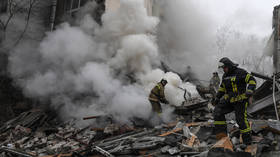Military Parade commemorates heroic past on Victory Day
The Victory Day Parade on Red Square has commemorated 64 years since the victory over Nazi Germany in World War II.
Victory Day is also known in Russia as 'the holiday with tears in the eyes'. The Soviet Union lost almost 27 million people from 1941 to 1945, and millions more were maimed.
The Victory parade grows in size every year, and this time it is the largest one seen since the fall of the Soviet Union.
Some 9,000 military personnel paraded through Red Square, and with the temperature about 22 degrees Celsius and beautiful weather, it was clear that nothing was going to rain on this parade.
Here are just a few highlights of the parade:
The clock on the Spassky tower in the Kremlin strikes 10 a.m. This marks the beginning of the parade.
The command is heard over the loud-speakers to carry out the flag of the Russian Federation and the Banner of Victory.
The soldiers and officers of the Guard of Honor Battalion have the honor of opening the victory parade on Russia’s main square.
A special Guard of Honor Company carries the banners representing the three main branches of the armed forces of Russia, the army, the air force, and the navy.
The Banner of Victory is of great importance because it was famously erected over the Reichstag building in Berlin towards the end of the war, and has now become the most important symbol to commemorate those killed in action during the war.
Taking the Salute at the Parade is Russian Defense Minister Anatoly Serdyukov.
Heading the parade is the Commander of the troops of the Moscow Military District, Colonel-General Valery Gerasimov.
The two limousines meet in the center of the square where General Gerasimov reports to Defense Minister Serdyukov that the troops are ready to begin their march.
However, before this all begins, the Minister and the General will do a review of the troops, where Minister Serdyukov congratulates all the units and detachments lined up along the perimeter of the square.
During the review, the Composite Military Orchestra of the Moscow garrison plays seven well-known marches.
The Defense Minister then proceeds towards the main stand on Red Square, where he reports to the Supreme Commander-in-Chief, President Dmitry Medvedev, that the parade is ready to begin.
President Medvedev makes a short speech after which the Russian National Anthem is played.
More than 9,000 servicemen take part in the parade which, by tradition, consists of three parts: The marching by of the soldiers and officers, the display of military hardware, and a flyover by aircraft and helicopters.
The march consists of battalion formations led by Colonel-General Valery Gerasimov. Following him, there are drummers from the Institute of Military Orchestra Conductors who set the pace and rhythm of the march.
The parade's musical accompaniment is provided by a 1000 person orchestra, along with a massive collective including armored vehicles, tanks, and massive anti-aircraft missile defense systems.
During the flyover part of the parade, helicopters and jets fly above the center of Moscow at speeds from 100 km/h to 550 km/h. Some notable helicopters include the ‘Black Shark’ and the ‘Alligator.'
The Su-25 jet makes a flyover as well. This plane has been dubbed the ‘flying tank’ due to the unprecedented armoring of the plane and pilot’s cabin.












